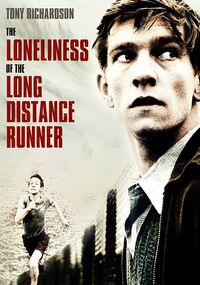The Loneliness Of The Long-Distance Runner: Difference between revisions
No edit summary |
No edit summary |
||
| (5 intermediate revisions by 2 users not shown) | |||
| Line 1: | Line 1: | ||
[[File:The Loneliness Of The Long-Distance Runner.jpg | 200px | right | thumb |The Loneliness Of The Long-Distance Runner film poster]] | |||
==Relevance== | ==Relevance== | ||
A version of the hymn "Jerusalem" by William Blake (sung by the Borstal Inmates in the film) was used for the [https://www.morrissey-solo.com/wiki/Boxers_Tour_1995_Pre-show_Tracks Boxers Tour 1995 Pre-show Tracks].<br> | |||
Featured in the opening sequence of [[Mention::Introducing Morrissey]]. | |||
<youtube>https://www.youtube.com/watch?v=07TLj2DFilg</youtube> | |||
{{Page | {{Page | ||
|DiscogsArtistId= | |DiscogsArtistId= | ||
|WikipediaPageTitle=The_Loneliness_of_the_Long-Distance_Runner | |WikipediaPageTitle=The_Loneliness_of_the_Long-Distance_Runner | ||
}} | }} | ||
[[Category:Influences on Morrissey - Film and Television]] | [[Category:Influences on Morrissey - Film and Television]] | ||
[[Category:Influences on Morrissey - Music]] | [[Category:Influences on Morrissey - Music]] | ||
[[Category:Featured in Morrissey / The Smiths video]] | |||
Latest revision as of 18:39, 17 August 2024
Relevance
A version of the hymn "Jerusalem" by William Blake (sung by the Borstal Inmates in the film) was used for the Boxers Tour 1995 Pre-show Tracks.
Featured in the opening sequence of Introducing Morrissey.
Mentioned In
- Tom Courtenay
- Boxers Tour 1995 Pre-show Tracks
- Outside/Southpaw Grammar Tour 1995 Pre-show Tracks
- Greatest Hits Tour 2007-2008 Pre-show Tracks
Wikipedia Information
 |
"The Loneliness of the Long-Distance Runner" is a short story by Alan Sillitoe, published in 1959 as part of a short story collection of the same title. The work focuses on Smith, a poor Nottingham teenager from a dismal home in a working class area, who has bleak prospects in life and few interests beyond petty crime. The boy experiences social alienation and turns to long-distance running as a method of both emotional and physical escape from his situation. The story was adapted for a 1962 film of the same title.
